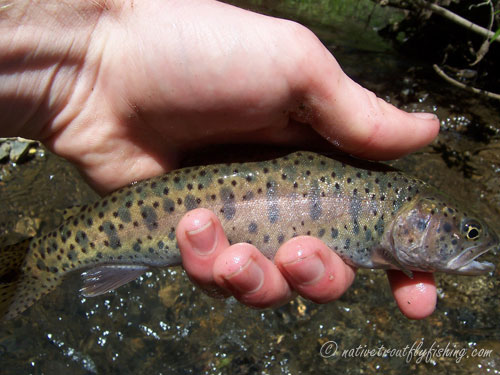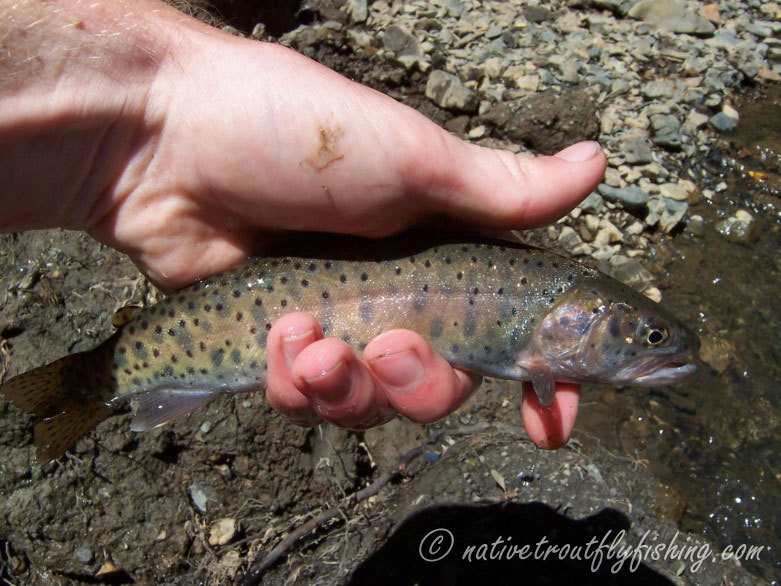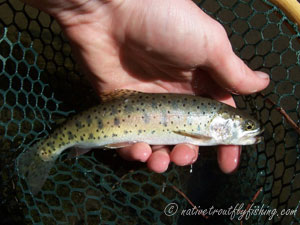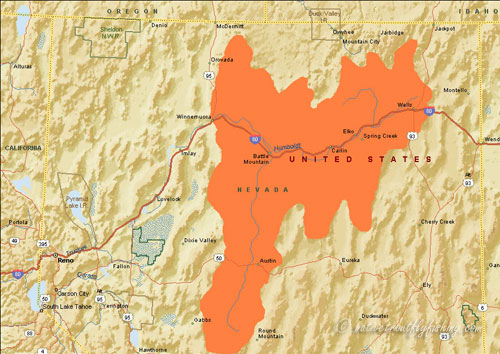Humboldt Cutthroat
Oncorhynchus henshawi humboldtensis
A Humboldt Cutthroat from small desert stream in Nevada.
Introduction
The Humboldt Cutthroat is a subspecies of Lahontan Cutthroat native to the Humboldt River drainage of Nevada. The Humboldt Cutthroat were formally described as the as the subspecies Oncorhychus clarkii humboldtensis in 2008 (Trotter and Behnke 2008). These Cutthroat have a significantly lower number of gill rakers compared to Lahontan Cutthorat, suggesting that they did not inhabit ancient Lake Lahontan, but instead were a stream dwelling form of Cutthroat even when access the lake was available (Benke 1992, Benke 2002). While the original description included the Humboldt Cutthroat Trout of the Quinn River and Coyote basins as well, more recent genetic evidence indicates that those two populaitons are distinct enough to warrant being their own subspecies (Trotter and Benhnke 2008, Peacock et al. 2018, Trotter et al. 2018). While the Humoldt Cutthroat certainly warrants its subspecies status, fisheries manageners often simply consider it as Lahontan Cutthroat, likely due to it not being separated from Lahontan Cutthroat in its Endangered Species Act listing.
Life History Information
The Humboldt Cutthroat is very well adapted to life in unstable high desert stream environments that experience a high degree of variability in flow and temperature. The Humboldt Cutthroat occurs primarily asstream resident and fluvial populations, although there are a few adfluvial populations as well.
Stream Resident Form
Today the stream resident life history is the predominant form of Humboldt Cutthroat remaining across its native range, with populations found in some of the smallest and most unstable streams in the Humboldt watershed. Stream resident Humboldt Cutthroat have been observed in streams with daily temperatures up to 83.3° F (28.5° C), but growth slows at such high temperatures and prolonged exposure is thought to be lethal (Dunham et al. 2003). During dry years when both low flows and high temperatures impact Humboldt Cutthroat, populations typically decline but are quick to rebound once conditions improve. Platts and Nelson (1983) showed that in a small Humboldt basin stream the abundance of a Cutthroat increased by three times over two consecutive high-water years. It is believed that part of this rapid increases in population size due to a high survival rate for eggs and juvenile fish. According to Trotter (2008) the eggs of Humboldt Cutthroat hatch faster than typical of other subspecies of Cutthroat. First spawning for these fish typically occurs at age-2 to age-3 and stream resident fish generally have an average size of 6" to 12" (15 cm to 30 cm) at maturity. The diet for these fish is composed mostly of aquatic and terrestrial insects and the maximum lifespan tends to be around age-4 to age-5 (Behnke 2002).
Fluvial Form
Although the fluvial component of the Humboldt Cutthroat was once widespread throughout the basin, it has been eliminated from much of its native range. Today the strongest populations of this life history form occur in the Marys River and South Fork of the Little Humboldt drainages (Elliot 2004). These fish spawn in small tributary streams, then migrate to the mainstem habitat to feed and overwinter. Generally, overwintering fish utilize large pools or beaver ponds and may travel distnaces of over one mile (1.5 km) to reach these locations (Ambruzs 2008). Many of the creeks that hold Humboldt Cutthroat Trout in the Marys River drainage dry up before connecting to larger the river as such spawning occurs to during spring, corresponding with the highest flows of the season (Trotter 2008). During this time mature Cutthroat run up even the smallest streams and seek out clean gravel to spawn in. As spawning evindents are highly dependent on high spring flows, there has been separate spawning runs each taking advantage of a high flow event to ascend tributaries that are inaccessible during low flow conditions (Nelson et al. 1987). As soon as spawning is complete the adult fish migrate back down to the river, where there is enough flow and pool habitat to support them throughout the dry season. Young-of-year Cutthroat hatch during the summer and seek out pools to allow them to survive the extreme temperatures, which range from in excess of 80° F (26.6° C) during summer to near freezing in the winter (Trotter 2008). By the following spring the juvenile fish will ride the high flows downstream to the river where they will feed and grow. Humboldt Cutthroat are opportunistic feeders, with most of their diet being composed of aquatic and terrestrial insects, although they will feed on fish when they are available (Dunham et. al 2000).
Adfluvial Form
There at least one known adfluvial population of Humboldt Cutthroat, which occurs in Willow Creek Reserevior. This reservoir is very eutrophic and as such experience massive blue-green algae blooms as well as temperatures in excess of 80° F (26.6° C) during the summer (Behnke 2002). Nevertheless, a small population Humboldt Cutthroat survive and even thrive in this environment, reaching sizes of 5lbs to 10lbs (2.3 kg to 4.5 kg). Typically, these fish will spend one to two years feeding in the reservoir before migrating up one of the small tributary streams for spawning. Spawn timings and migration patterns for this adfluvial population appear to be very similar to those of fluvial populations. It is thought that this population is currently extremely limited due to habitat degradation in the streams above the reservoir.
Status
It is believed that during wet years these fish were historically found in as much as 2,200 miles (3,540 km) of stream habitat. Today this number has been greatly reduced and depending on conditions Humboldt Cutthroat inhabit between 180 and 250 miles (290 km to 402 km) in around 70 different streams across the basin (Elliot2004). As a result of this substantial decline, the Humboldt Cutthroat were listed along with the other Lahontan Cutthroat subspecies as endangered under the Endangered Species Preservation Act in 1970, although they were down listed to threatened under the Endangered Species Act in 1975 to increase the feasibility of restoration efforts (USFWS 1970, USFWS 1975). Habitat degradation and the introduction of non-native trout have been the two leading causes of decline for the Humboldt Cutthroat, although over harvest has also played a role in some waters. Oddly enough habitat degradation has also been a bit of a blessing in disguise for these Cutthroat in some cases. Due to the harsh conditions these fish have adapted to survive in, they have managed to maintain a hold in many degraded streams in which introduced trout could not survive (Platts and Nelson 1983, Nelson et al. 1992). In fact, today there are only four streams in the upper Humboldt River drainage that are known to contain Rainbow-Cutthroat hybrids (Elliot 2004). It is only in the "highest quality" cold mountain streams that Humboldt Cutthroat have been completely replaced by introduced species. In streams where Brook Trout have been introduced, a high amount of diet overlap has been observed suggesting that competition between the two species is high (Dunham et al. 2000).
While habitat degradation has shielded Humboldt Cutthroat from the impacts of non-native trout, it has also resulted in the loss of many populations across their range. Like trout native to arid regions across the West, grazing, and water diversions have both had a major impact on populations of Humboldt Cutthroat. Water diversions have been an issue for trout in the Humboldt drainage causing low flows and high temperatures and, in some cases, complete dewatering in the lower reaches of streams. When it comes to grazing impacts, typically the best area for free-range cattle to graze is in the riparian zone along streams (Platts and Nelson 1985). This zone is vital to the survival of trout and helps to keep water temperatures cool and stream banks stable, reducing sedimentation. As cattle consume and trample the riparian vegetation the amount of shade drops, and water temperature rise to levels are often lethal to the trout. The other affect is that stream banks become less stable and more prone to incising. During the high flows of spring when the Cutthroat are spawning, this equates to an increase in the sediment load and lower survival rate for eggs, as well as a reduction in off channel areas that are essential nursery areas for juvenile Cutthroat. The negative effects of cattle grazing could easily be seen in a stream that I visited for these trout in 2006. There were sections of this stream where cattle had completely caved the banks of the stream in causing it to run murky and cut itself into a 10 to 15 ft (3 to 4.5 m) deep trench.
The combination of these poor land use practices has resulted in habitat fragmentation, which appears to be a major limiting factor for Humboldt Cutthroat and makes individual populations more susceptible to being lost. Dunham et al. (1997) found that 89% of stream basins that were contained Humboldt Cutthroat when they were connected to another stream basin containing Humboldt Cutthroat. However, only 32% of isolated stream basins contained Humboldt Cutthroat. In isolated streams, a lack of suitable habitat for Humboldt Cutthroat, such as pools often results in a low effective populations size resulting in negative genetic effective and in some cases an inability to adapt to changing conditions (Peacock and Dochtermann 2012).
To help assist the recovery of Humboldt Cutthroat and preservation of their habitat, the Nevada Department of Wildlife launched the safe harbor program, which guarantees no additional restrictions on the use of a landowner’s land if they improve, restore, or create habitat for Humbodlt Cutthroat or other endangered species (NDOW 2007). Largely due to these safe harbor agreements, 36 miles of interconnected habitat, mostly in the Maggie Creek watershed is now available to Humoldt Cutthroat. A study on this watershed showed that after reconnecting the formely fragmented habitat in the basin, Humoldt Cutthroat densities increase three-fold and that the watershed supported significantly more large migratory fish (Neville et al. 2016). Beyond reconnecting stream habitat, the US Forest Service and Bureau of Land Management have created fenced off enclosures along the riparian zones of streams containing Humboldt Cutthroat and with the improved habitat the populations are beginning to rebound in many watersheds.
Description
Due to a long period isolation between many of the populations of Humboldt Cutthroat there is a high degree of variation in their features across their native range. The coloration of this trout tends to be an olive-bronze to copper color on the back which transitions to a pale yellow with hints of red on the side. Humboldt Cutthroat have a dull almost dirty looking red or pink stripe along their lateral line and on their gill plates, which tends to be much more pronounced in spawning males (Behnke 2002). They also have a red Cutthroat mark below the lower jaw and many stream resident populations will retain bluish purple colored parr marks into adulthood. Humboldts tend to be a little more sparsely spotted than Lahontan Cutthroat and have spots spread evenly across their backs and sides of their bodies.
Stream Resident Form
Click on images to view a larger picture
Native Range
A map of the native range of the Humboldt Cutthroat trout. Data Source: Behnke (2002) and Trotter (2008).
References
Ambruzs, S.L. 2008. Winter movement of Lahontan Cutthroat Trout in Marys River, Nevada. Masters Thesis. University of Nevada. Reno, Nevada.
Dunham, J.B., G.L. Vinyard and B.E. Rieman. 1997. Habitat fragmentation and extinction risk of Lahontan cutthroat trout. North American Journal of fisheries Management 17:1126-1133.
Dunham, J.B., M.E. Rahn, R.E. Schroeter and S.W. Breck. 2000. Diets of sympatric Lahontan cutthroat trout and nonnative brook trout: implications for species interactions. Western North American Naturalist 60(3): 304–310.
Dunham, J., R. Schroeter and B. Rieman. 2003. Influence of maximum water temperature on occurrence of Lahontan cutthroat trout within streams. North American Journal of Fisheries Management 23: 1042–1049.
Elliott, J. 2004. Lahontan cutthroat trout species management plan for the Upper Humboldt River drainage basin. Nevada Department of Wildlife, Carson City, NV.
NDOW. 2007. Safe harbor agreement for voluntary enhancements/ restoration activities benefiting Lahontan cutthroat trout on non-federal lands with the Upper Humbodlt River distinct population segment area. Nevada Department of Wildlife, Carson City, NV.
Nelson, R.L., W.S. Platts and O. Casey. 1987. Evidence for variability in spawning behavior of interior cutthroat trout in response to environmental uncertainty. Great Basin Naturalist 47(3): 480-487.
Nelson, R.L., W.S. Platts, D.P. Larsen and S.E. Jensen. 1992. Trout distribution and habitat in relation to geology and geomorphology in the North Fork Humboldt River drainage, Northeastern Nevada. Transactions of the American Fisheries Society 121: 405-426.
Neville, H.M. D. Dauwalter and M. Peacock. 2016. Monitoring demographic and genetic responses of a threatened inland trout to habitat reconnection. Transactions of the American Fisheries Society 145: 610-26.
Peacock, M.M. and N.A. Dochtermann. 2012. Evolutionary potential but not extinction risk of Lahontan cutthroat trout (Oncorhynchus clarkii henshawi) is associated with stream characteristics. Canadian Journal of Aquatic and Fisheries Sciences 69: 615-626.
Peacock, M.M., H.M. Neville and A.J. Finger. 2018. The Lahontan basin evolutionary lineage of Cutthroat Trout. Pages 231-259 in Trotter P, Bisson P, Schultz L, Roper B (editors). Cutthroat Trout: Evolutionary Biology and Taxonomy. Special Publication 36, American Fisheries Society, Bethesda, Maryland.
Platts, W.S. and R.L. Nelson. 1983. Population fluctuations and genetic differentiation in the Humbodlt cutthroat trout of Gance Creek, Nevada. California and Nevada Wildlife Transactions 15-19.
Platts, W.S. and R.L. Nelson. 1985. Streamside and upland vegetation use by cattle. Rangelands 7(1): 5-7.
Trotter, P. 2008. Cutthroat: Native Trout of the West. Second Edition. University of California Press, Berkley, CA.
Trotter, P.C. and R.J. Behnke. 2008. The case for humboldtensis: a subspecies name for the indigenous cutthroat trout (Oncorhynchus clarkii) of the Humboldt River, upper Quinn River, and Coyote Basin drainages, Nevada and Oregon. Western North American Naturalist, 68(1): 58-65.
Trotter, P., P. Bisson, B. Roper, L. Schultz, C. Ferraris, G.R. Smith and R.F. Stearley. 2018. A special workshop on the taxonomy and evolutionary biology of cutthroat trout. Pages 1-31 in Trotter P, Bisson P, Schultz L, Roper B (editors). Cutthroat Trout: Evolutionary Biology and Taxonomy. Special Publication 36, American Fisheries Society, Bethesda, Maryland.
USFWS. 1970. United States List of Endangered Native Fish and Wildlife. Federal Register 35:16047-16048.
USFWS. 1975. Threatened Status for Three Species of Trout (Lahontan cutthroat, Salmo clarki henshawi; Paiute cutthroat, Salmo clarki seleniris; Arizona trout, Salmo apache). FR 40:29863-29864.
USFWS. 1995. Lahontan cutthroat trout, Oncorhynchus clarki henshawi, recovery plan. United States Fish and Wildlife Service. Portland, Oregon. 147 pp.
Contact
Feel free to contact me if you have any questions or comments
Humboldt Cutthroat Trout Links
Nevada Department of Wildlife - Lahontan Cutthroat
Humboldt-Toiyabe National Forest
Bureau of Land Management - Nevada
U.S. Fish and Wildlife Service - Lahontan Cutthroat
Western Native Trout Initiative - Lahontan Cutthroat Trout
Native Trout Links
Truchas Mexicanas' - Native Trout of Mexico
Balkan Trout Restoration Group
Trout and Seasons of the Mountain Village - About Japanese Trout
Western Native Trout Challenge
California Heritage Trout Challenge
Fly Fishing Blogs
Dave B's Blog: Fly Fishing for Native Trout
The Search for Native Salmonids
Conservation Links
Western Native Trout Initiative
Fly Fishing Links
Fishing Art Links
Americanfishes.com - Joseph R. Tomelleri



